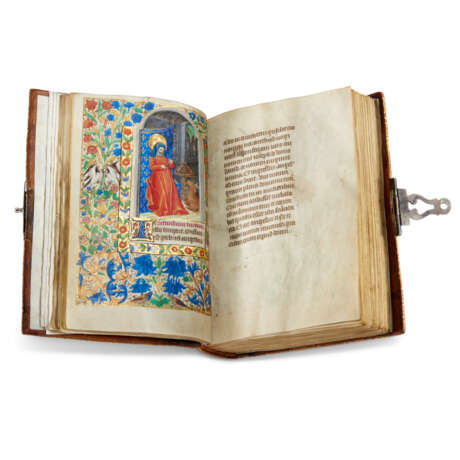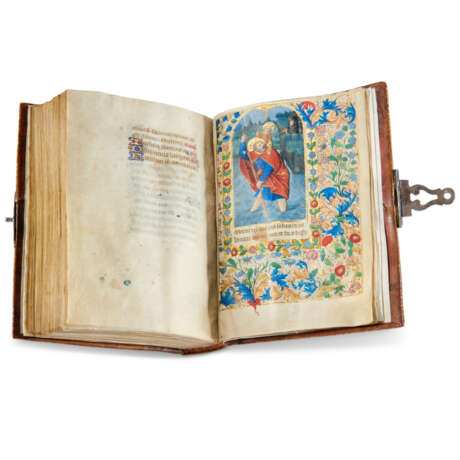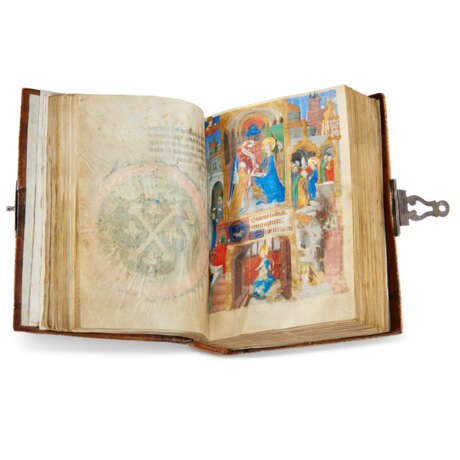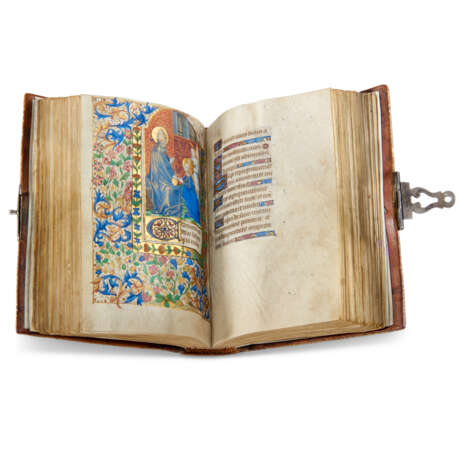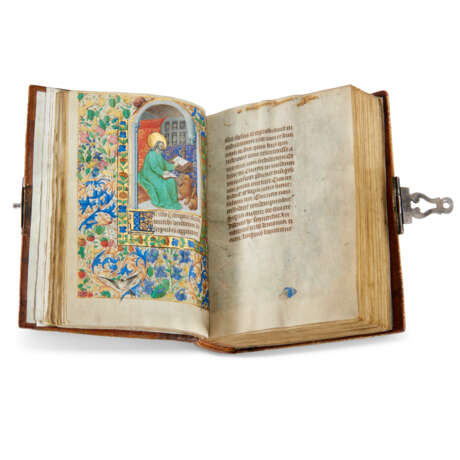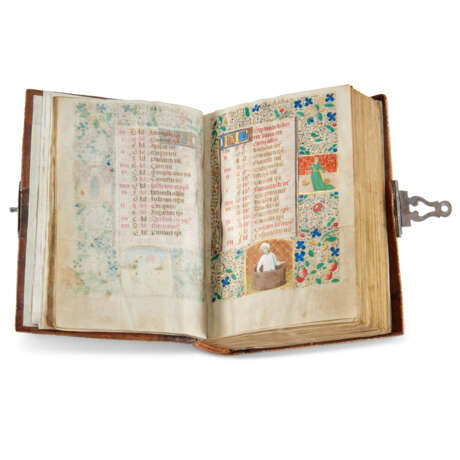The Master of Marguerite de Foix (active second half 15th century)
10.07.2024 10:30UTC +00:00
Classic
Verkauft
12600GBP £ 12 600
| Auctioneer | CHRISTIE'S |
|---|---|
| Veranstaltungsort | Vereinigtes Königreich, London |
| Aufgeld | see on Website% |
Archiv
Die Auktion ist abgeschlossen. Es können keine Gebote mehr abgegeben werden.

ID 1249821
Los 30 | The Master of Marguerite de Foix (active second half 15th century)
Schätzwert
£ 12 000 – 18 000
Book of Hours, use of Rome, in Latin, illuminated manuscript on vellum [Nantes, c.1460]
The reappearance of a significant Breton Book of Hours, a rare example of the work of the Master of Marguerite de Foix that still delights despite some damage.
128 x 98mm. iii + 166 + i leaves, modern partial foliation incorrect and not followed here: 15(of 6, lacking i), 26, 36(of 8, lacking ii-iii), 47(of 8, lacking vi), 57(of 8 lacking v), 6-98, 107(of 8, lacking viii), 116(of 8, lacking iv and vii), 12-138, 143(of 4, iv cancelled blank), 157(of 8, lacking i), 16-178, 186(of 8, lacking ii and v), 19-228, 234, 256(of 8, lacking i and iii), 15 lines, ruled area: 62 x 41mm, one historiated initial with full border, 22 small calendar miniatures in eleven full borders, 14 large miniatures with full borders, one historiated and the others of naturalistic plants and stylised acanthus and flowers, one with roundel and some with birds (lacking one illuminated calendar leaf and at least ten leaves with miniatures, trimmed at top to border frames, wear to many leaves and to miniatures except ff.14v and 16v, extensive on ff.66v, 79v, 162v. 163v, 164v, wear to borders including the historiated border f.32, some offsetting from miniatures and borders, cancelled inscription f.17). Late 17th-century brown morocco gilt, spine in six compartments gilt, metal clasp and catch (joints repaired, clasp and catch not original). Half morocco brown box by James Brockman, with vellum binding fragments mounted in upper cover.
Provenance:
(1) On f.32, a damaged and illegible coat of arms, azure with at least one charge (?a quatrefoil) in argent, appears in the initial and in the shield in the architectural framing at bottom left. The Calendar shows that the book was intended for a Breton patron: in red are Sts Guénolé, founder of the Abbey of Landévannec (3 March), Paternus, Bishop of Vannes (16 April and translation 21 May), Yvo (19 May and translation 29 Oct.), Donatian and Rogatian, the martyrs of Nantes (24 May), Solomon, King of Brittany (25 June), Clarus, Bishop of Nantes, and Paul, Bishop of Léon (10 Oct.), and Corentin, Bishop of Quimper (12 Dec.). In black are Sts Thuriau (13 June) and Samson (28 July), both Bishops of Dol, Armel (16 Aug.), Martin, Abbot of Vertou near Nantes (24 Oct.), Gobrianus Bishop of Vannes (3 Nov.), Maclou (Malo, 15 Nov.), Maudez (18 Oct.) In the litany, Donatian and Rogatian, Solomon and Yvo are invoked, along with Guinen, possibly Guénin, Bishop of Nantes. From the style of illumination, the book was probably produced in Nantes towards 1460, a date supported by the presence of the Franciscan St Bernadino in the litany: he died in 1444 and was canonised in 1450. Both major feasts of St Francis are in red in the calendar (25 May and 4 Oct.) and he and St Clare appear in the litany. Prayers are in the masculine.
(2) The coat of arms of a probably 17th-century possibly Italian owner were added on ff.31 (in wreath), 34 and 43: azure, a saltire trefly or between four trefoils of the same. The family of Le Barbu in Brittany, which ended with an heiress in the 15th century, had the same charge without the trefoils, as did the Bonaggiunti Vignali of Siena. There is a note in Italian on f.166.
(3) A 17th-18th-century hand added the opening of terce, ff.70v-71, lost with the removal of the miniature, showing that leaves had already been excised by that date.
(4) Christie's, 13 December 1984, lot 131.
(5) Sotheby’s, 20 June 1995, lot 111.
Content: Calendar, lacking January, ff.1-11; Gospel extracts, lacking the end of John and the beginning of Matthew ff.12-17v; Obsecro te ff.18-22v; O intemerata, lacking opening, ff.23-26v; Stabat mater ff.26v-28v; two prayers to Christ, the first O bone Jhesu lacking opening ff.29—39; Office of the Virgin, use of Rome ff.32-95v: matins f.32, lauds f. 53v, prime f.65v, terce, lacking opening, f.71, sext lacking opening and end f.74, none lacking opening f.76, vespers f.79v, compline f.85v, seasonal variants f.88v; Penitential Psalms and litany, lacking opening and end of concluding prayers, ff.96-119v; Hours of Cross, lacking opening and end, ff.120-121v; Hours of the Holy Ghost, lacking opening, ff.122-123v; Office of the Dead, unidentified variant of the use of Rome ff.125-160v; Memorials, lacking opening leaf, ff.161-165: Sts Christopher f.161, Vincent, lacking opening, f.162, Katherine f.162v, Margaret f.163v, Barbara f.164v; poem attributed to Urban V (Pope 1362-1370), Balsamus et munda cera, added in a 15th -or 16th-century hand on ruled blank f.166.
The Office of the Dead is recorded by Ottosen in only two books of unknown origin (The Responsories and Versicles of the Latin Office of the Dead, 2007, S.1939-1, pp.140, 273); this manuscript suggests it was current in Brittany.
The added poem was written for the papal blessing of wax Agnus dei (Lamb of God) images at the first Easter of a new pope and every seven years thereafter. It became more widely known after it was set as a motet by Guillaume Dufay for Pope Eugenius IV in 1431.
Illumination:
The strikingly accomplished illumination is by the Master of Marguerite de Foix, named from the Book of Hours produced for the Navarrese princess as Duchess of Brittany, now London, Victoria and Albert Museum, MSL/1910/2385 (Salting 1222), an attribution first made by François Avril (see bibliography). Appropriately for the mother of Anne of Brittany, twice Queen of France and owner of famed masterpieces of illumination, Marguerite de Foix’s Hours is a book of great quality, remarkable for its fusion of the spatial innovations of Jean Fouquet with the Parisian inspired art of the Jouvenel group of illuminators. Although coherent in style, the Duchess’s book seems to be the work of more than one hand, as seems likely for the present lot, although its condition makes precise attribution difficult for some miniatures. Nonetheless, its reappearance confirms its place as one the rare examples of the Master’s work, as first assembled by Eberhard König (Französische Buchmalerei um 1450, 1982, p.253) and augmented by Joris Corin Heyder (see below).
The Master of Marguerite de Foix stands out for the strong three dimensionality of his settings and expressive figures, his delight in rich colour with a lavish use of gold to highlight and detail – patterned cloth of gold hangings often form backdrops – and interest in exotic costume, so that turbaned figures appear in the Calendar alongside more conventionally clad nobles and peasants. Allowing for its larger size , his name work and the present lot share compositional and figure patterns and have similarly gorgeous borders, delightfully enlivened by realistic and stylised birds. Note also in our manuscript the snail slithering round St Mark’s frame, f.16v. In both, the central Annunciation scenes are very similar but the architectural framing around our miniature appears in the Duchess’s Hours around the Visitation, f.47. The Annunciation pattern, complete with architectural border, and our miniature for the Office of the Dead, f.125, are derived from the Parisian Bedford and Dunois Masters, probably though the Jouvenel group, despite the presence of original works by the Bedford Master in Brittany. The whole Annunciation page, f.32 in the present lot, is an extremely close variant of that in the Jouvenel Master’s chef d’oeuvre, the Hours of Jeanne de France, Duchess of Bourbon, who personalised a book made originally c.1450 for a Breton princess (Paris, BnF ms NAL 3244, f.35).
Marguerite’s Hours can be dated between her marriage to François II of Brittany in 1471 and, possibly, the birth of her first child, Anne, in 1477. The style of both miniatures and calendar borders in the present lot indicates an earlier date, towards or around 1460, with evident influence from artists associated with the Jouvenel Master, with whom Fouquet was also connected. The Jouvenel Group, active probably in Angers from the 1440s, have also been placed in Nantes from their connections with Breton manuscript production. Nantes, where the Dukes chiefly resided, is the most likely location for the Master of Marguerite de Foix, as supported by an Hours for the Use of Nantes in the Bibliothèque Ste-Geneviève in Paris, ms 1277. There the Master’s intervention is limited to touching up some heads, for instance, God in the Coronation of the Virgin, f.68, who is strikingly similar to the God in our miniature, f.85v, more elaborate and ambitious version of the simple composition in the probably earlier Hours. Also signalled by Heyder is a devotional treatise in Oxford (Bodleian Library, ms Douce 134), which comes closer to the exceptional quality of Marguerite de Foix’s Hours and of the present lot, a quality still evident despite its condition.
The subjects of the large miniatures are: St John the Evangelist on Patmos with a roundel of John in the boiling oil in the lower margin f.12, St Luke f.14v, St Mark f.16v, the Virgin and Child between musician angels f.18, the Annunciation with a historiated border in a unified architectural faming with scenes of the Presentation of the Virgin, the Virgin weaving and the Marriage of the Virgin f.32, the Visitation f.53v, the Nativity f.66v, the Flight into Egypt f.79v, the Coronation of the Virgin f.85v, the Office of the Dead recited around the coffin in a church f.125, St Christopher f.161, St Katherine f.162v, St Margaret f.163v, St Barbara f.164v.
The subjects of the border miniatures in the calendar are: Pisces, a man warming himself at a fire f.1, Aries, man pruning f.2, Taurus, nobleman walking through landscape with left hand to hilt of sword (?first underdrawn as a leafy branch) f.3, Gemini as two conjoined females with two legs (originally drawn with four legs), man hawking on horseback f.4, Cancer, man scything hay f.5, Leo, man binding sheaves of wheat f.6, Virgo, man threshing f.7, Libra, man treading grapes f.8, Scorpio, man sowing f.9, Sagittarius, man knocking down acorns for pigs f.10, Capricorn, man about to stun pig f.11.
The subject of the historiated initial is the Mater dolorosa, mourning Virgin f.126v.
Literature
F. Avril, ‘Les copies à répétition. A propos de la circulation et de la dissémination des modèles’, Tributes to Jonathan J.G. Alexander, S. L’Engle and G.B. Guest eds., 2006, pp. 127-133, this ms p.131 and fig.8
R. Watson, Western Illuminated Manuscripts. Victoria and Albert Museum. A catalogue of works in the National Art Library, 2011, vol.1, the Hours of Margaret de Foix, pp. 301-311, cat. 53, this ms p.311
P. Contamine and M.-H. Tesnières, ’Jeanne de France, duchesse de Bourbon, et son livre d’heures’, Monuments et mémoires de la Fondation Eugène Piot, 92, 2013, pp.5-65, this ms p.38
J. C. Heyder, ‘Les Heures de Marguerite de Foix: sources artistiques d’un atelier Nantais presque inconnu’, N. Faucherre and J.-M. Guillouet eds, Nantes flamboyante (1380-1530), 2014, pp.123-139, this ms pp.133-135.
| Herkunftsort: | Westeuropa, Frankreich, Europa |
|---|---|
| Kategorie des Auktionshauses: | Handschriften des Mittelalters und der Renaissance, Bücher und Handschriften |
| Herkunftsort: | Westeuropa, Frankreich, Europa |
|---|---|
| Kategorie des Auktionshauses: | Handschriften des Mittelalters und der Renaissance, Bücher und Handschriften |
| Adresse der Versteigerung |
CHRISTIE'S 8 King Street, St. James's SW1Y 6QT London Vereinigtes Königreich | |
|---|---|---|
| Vorschau |
| |
| Telefon | +44 (0)20 7839 9060 | |
| Aufgeld | see on Website | |
| Nutzungsbedingungen | Nutzungsbedingungen |
